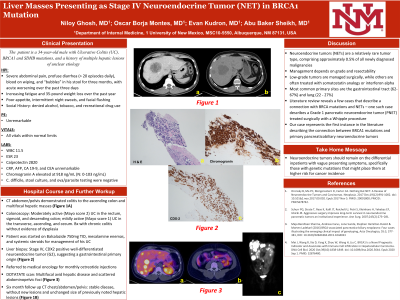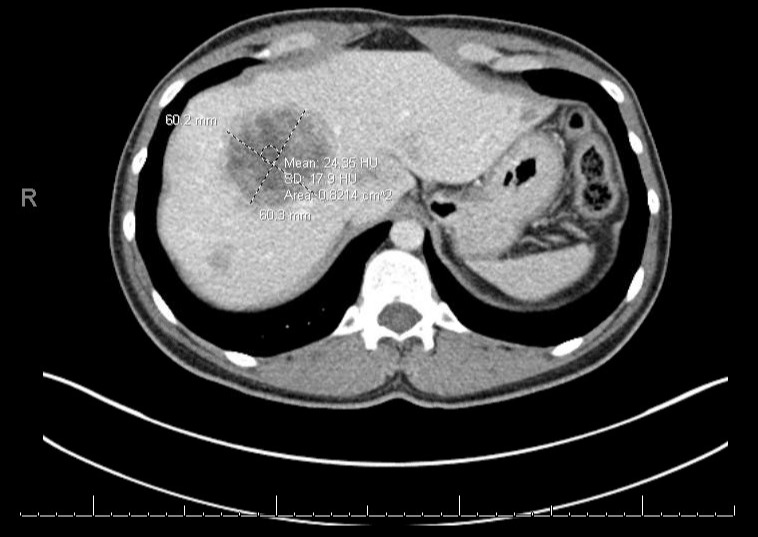Tuesday Poster Session
Category: Liver
P3878 - Liver Masses Presenting as Stage IV Neuroendocrine Tumor in BRCA1 Mutation
Tuesday, October 24, 2023
10:30 AM - 4:00 PM PT
Location: Exhibit Hall

Has Audio

Niloy Ghosh, MD
University of New Mexico Health Sciences Center
Albuquerque, NM
Presenting Author(s)
Niloy Ghosh, MD1, Oscar Borja Montes, MD2, Evan Kudron, MD1, Abu Baker Sheikh, MD1
1University of New Mexico Health Sciences Center, Albuquerque, NM; 2University of New Mexico, Albuquerque, NM
Introduction: Neuroendocrine tumors (NETs) are a relatively rare tumor type, comprising approximately 0.5% of all newly diagnosed malignancies. In this report, we describe the case of expanding liver masses presenting as a Stage IV NET in a patient with BRCA1 mutation.
Case Description/Methods: A 34-year-old man presented with severe abdominal pain, diarrhea, blood on wiping, and “bubbles” in his stool for three months, with acute worsening over the past three days. He also endorsed a 35-pound weight loss over the past year along with poor appetite, intermittent night sweats, and facial flushing. Past medical history included UC, BRCA1 mutation, and a history of multiple hepatic lesions of unclear etiology. Admission labs demonstrated WBC 11.5, albumin 3.2, ESR 23, and calprotectin 2820. CRP, AFP, CA 19-9, and CEA were unremarkable, and the C. difficile, stool culture, and ova/parasite testing were negative. CT abdomen/pelvis demonstrated colitis to the ascending colon and multifocal hepatic masses.
Gastroenterology was consulted and colonoscopy showed chronic colitis without evidence of dysplasia. The patient was started on Balsalazide 750mg TID and mesalamine enemas for management of his UC. Further work-up included a liver biopsy, significant for Stage IV, CDX2 positive well-differentiated neuroendocrine tumor (G2), suggesting a gastrointestinal primary origin. The patient was referred to medical oncology for monthly octreotide injections and follow-up DOTATATE scan, which showed multifocal avid hepatic disease and scattered abdominal pelvic foci. Repeat CT chest/abdomen/pelvis six months later showed stable disease, without new lesions and unchanged size of previously noted hepatic lesions.
Discussion: NET management depends on grade and resectability. Low-grade tumors are managed surgically, while others are often treated with somatostatin analogs or interferon alpha. The most common primary sites are the gastrointestinal tract (62-67%) and lung (22 - 27%). To date, there are few cases that describe a connection with BRCA mutations and NETs – one such case describes a Grade 1 pancreatic neuroendocrine tumor (PNET) treated surgically with a Whipple procedure. Our case represents the first instance in the literature describing the connection between BRCA1 mutations and primary pancreaticobiliary neuroendocrine tumors, proving they should remain on the differential in patients with vague presenting symptoms, specifically those with genetic mutations that might place them at higher risk for cancer incidence.

Disclosures:
Niloy Ghosh, MD1, Oscar Borja Montes, MD2, Evan Kudron, MD1, Abu Baker Sheikh, MD1. P3878 - Liver Masses Presenting as Stage IV Neuroendocrine Tumor in BRCA1 Mutation, ACG 2023 Annual Scientific Meeting Abstracts. Vancouver, BC, Canada: American College of Gastroenterology.
1University of New Mexico Health Sciences Center, Albuquerque, NM; 2University of New Mexico, Albuquerque, NM
Introduction: Neuroendocrine tumors (NETs) are a relatively rare tumor type, comprising approximately 0.5% of all newly diagnosed malignancies. In this report, we describe the case of expanding liver masses presenting as a Stage IV NET in a patient with BRCA1 mutation.
Case Description/Methods: A 34-year-old man presented with severe abdominal pain, diarrhea, blood on wiping, and “bubbles” in his stool for three months, with acute worsening over the past three days. He also endorsed a 35-pound weight loss over the past year along with poor appetite, intermittent night sweats, and facial flushing. Past medical history included UC, BRCA1 mutation, and a history of multiple hepatic lesions of unclear etiology. Admission labs demonstrated WBC 11.5, albumin 3.2, ESR 23, and calprotectin 2820. CRP, AFP, CA 19-9, and CEA were unremarkable, and the C. difficile, stool culture, and ova/parasite testing were negative. CT abdomen/pelvis demonstrated colitis to the ascending colon and multifocal hepatic masses.
Gastroenterology was consulted and colonoscopy showed chronic colitis without evidence of dysplasia. The patient was started on Balsalazide 750mg TID and mesalamine enemas for management of his UC. Further work-up included a liver biopsy, significant for Stage IV, CDX2 positive well-differentiated neuroendocrine tumor (G2), suggesting a gastrointestinal primary origin. The patient was referred to medical oncology for monthly octreotide injections and follow-up DOTATATE scan, which showed multifocal avid hepatic disease and scattered abdominal pelvic foci. Repeat CT chest/abdomen/pelvis six months later showed stable disease, without new lesions and unchanged size of previously noted hepatic lesions.
Discussion: NET management depends on grade and resectability. Low-grade tumors are managed surgically, while others are often treated with somatostatin analogs or interferon alpha. The most common primary sites are the gastrointestinal tract (62-67%) and lung (22 - 27%). To date, there are few cases that describe a connection with BRCA mutations and NETs – one such case describes a Grade 1 pancreatic neuroendocrine tumor (PNET) treated surgically with a Whipple procedure. Our case represents the first instance in the literature describing the connection between BRCA1 mutations and primary pancreaticobiliary neuroendocrine tumors, proving they should remain on the differential in patients with vague presenting symptoms, specifically those with genetic mutations that might place them at higher risk for cancer incidence.

Figure: Multifocal hepatic masses in the setting of BRCA1 Mutation
Disclosures:
Niloy Ghosh indicated no relevant financial relationships.
Oscar Borja Montes indicated no relevant financial relationships.
Evan Kudron indicated no relevant financial relationships.
Abu Baker Sheikh indicated no relevant financial relationships.
Niloy Ghosh, MD1, Oscar Borja Montes, MD2, Evan Kudron, MD1, Abu Baker Sheikh, MD1. P3878 - Liver Masses Presenting as Stage IV Neuroendocrine Tumor in BRCA1 Mutation, ACG 2023 Annual Scientific Meeting Abstracts. Vancouver, BC, Canada: American College of Gastroenterology.
